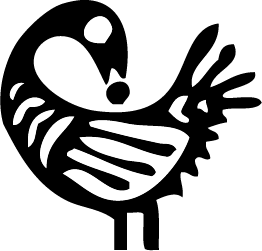Artistic Reflections on the Possibilities of 2021
 Source: Berea College, Carter G. Woodson Center
Source: Berea College, Carter G. Woodson Center
Looking Back to Move Forward Collectively
By Emilie Diouf
IMPACT Leadership Circle
To ground artistic reflections on possibilities for 2021, I'd like to conjure the image of the Sankofa bird, an element of the Adinkra system emanating from the Akan people of Ghana and Ivory Coast. The Sankofa image is a communicator in the Adinkra system, often represented as a mythical bird with its feet firmly planted forward and its head turned backwards. The Sankofa bird signifies a philosophical approach to the past as a rearview mirror for understanding our present while we move into the future. Its multifarious diasporic meanings revolve around the principle that wisdom in learning from the past ensures a strong future.
In the midst of devastating challenges of the global Covid-19 pandemic, political discord, and the ongoing fight against systemic racism and oppression, a meditation on the relation between past, present, and future is not futile. While still mourning the terrible losses of the Covid-19 pandemic and grappling with disquieting global inequities, we are compelled to examine our humanity in all its temporalities. Responding to a year of individual and collective critical evaluation of time, space, and movement in the stillness of quarantine, artists from different corners of the globe have been instrumental in challenging us to rethink universal humanity, particularly in relation to systemic structures of power such as race, ethnicity, gender, sex, class, age, ability, religion, and caste. Their creative ability to articulate the desperation, anguish, and sometimes, shame, of the present moment, but also possibilities to reinvent ourselves have imbued us with hope. These artistic voices pierce through the wall of the pandemic to confront us with an obvious yet discarded question: how do we explain situations in which some forms of suffering are recognized only to be compounded, while other forms of suffering remain invisible? They open up possibilities for co-creating new vocabularies of empathy that draw from our shortcomings to conceptualize and help us feel compassion toward one another.
I would like to end by referring once again to the image of the Sankofa bird. As we are at the threshold of a new year, I would like to invite everyone to adopt the stance of the Sankofa bird, even if for a moment, to gaze back below the surface of our past experiences; to shift this gaze into the present for a creative reclaiming of our ability to resist and persist in the midst of the challenges that surround each of us. I hope that this Sankofa-inspired way of looking will open up new avenues for inclusive paradigms to redefine our humanness for a more peaceful and equitable world. I remain inspired by young artists like singer Lady Mounass and painter Di'art Rietou, both of Senegal, who, through their works, contemplate and grapple with the daily lives of Senegalese women survivors of rape and domestic violence. Through their creativity, I perceive aesthetics and ethics of care encapsulated by their devotion to reinventing themselves and moving their communities one step closer to social transformation.
Dewenati!!! (a Wolof word that means "may we live to celebrate it next year")
May 2021 be artistically regenerative.